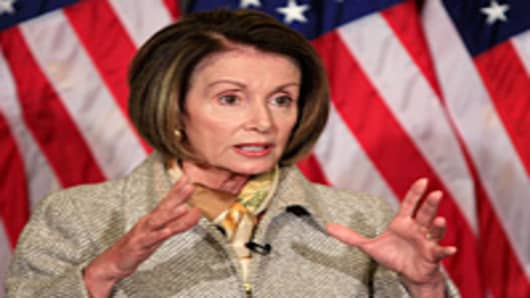The favored route of economists is known as a value-added tax, which is a tax on goods and services that is collected at every step along the production chain, from raw material to a consumer’s shopping bag. Similar to a sales tax, it generally results in consumers paying more for the things they buy. The revenues could be used to pay for health care or other social programs, or just to pay down existing debt.
Like universal health care, every other industrialized country in the world already has a value-added tax (as do about 100 emerging countries). And also like universal health care, this once-taboo policy option has recently been invoked, at times begrudgingly, by many prominent Washingtonians, including the House speaker, Nancy Pelosi; John Podesta, who was co-chairman of President Obama’s transition team; and two former Federal Reserve chairmen, Alan Greenspan and Paul A. Volcker
Introducing such a tax would probably require an overhaul of the entire federal tax code, no small order, and something the government last did in 1986. At the time the goal was to simplify the tax system, to raise money more efficiently and with fewer headaches for taxpayers.
Since then, federal spending has ballooned, while the government’s ability to raise taxes has become increasingly inefficient. Consider the page length of the tax code and tax regulations, which has expanded by more than 70 percent, according to Thomson Reuters Tax and Accounting. (There are more words crammed onto each page, too.)
The tax system is now a compendium of lobbied-for ifs, ands and buts. As the tax code has been embellished and then Swiss-cheesed, the portion of Americans footing the nation’s income tax bill has shrunk.
“There are many more deductions and credits, which can often encourage inefficient behavior such as tax shelters,” said Leonard E. Burman, a public affairs professor at Syracuse University, about the changes to the tax system since the 1986 reform. “The ideal tax system has a broad base — few deductions or exemptions — and low rates.”
Most of the rest of the industrialized world — including, most recently, Australia — has already taken this lesson to heart by imposing value-added taxes. Unlike income taxes, which are often front-loaded on the rich, then subsequently diluted, a value-added tax is paid by almost everybody. That broad base is one of its major advantages, and why the International Monetary Fund frequently recommends it to countries that need to raise money quickly.
What is good for economic purposes, however, can be bad politics, especially since Mr. Obama pledged not to raise taxes on the bottom 95 percent of Americans. (And many Republicans have pledged not to raise taxes on the bottom 100 percent of Americans.)
The value-added tax is also the darling of many economists for its bounce-a-quarter-off-its-abs efficiency. Its administrative costs to the government are generally low. It is also considered less of a drag on the economy over the long run than raising income taxes, which discourage people from saving money and thereby making capital available to businesses.
To understand why a value-added tax is considered so efficient, you have to understand how it usually works.
Imagine the production of a new dress, in three steps:
- A fabric store sells a tailor enough silk to make one dress, at a total price of $10 before taxes;
- The tailor sews a dress and sells it to Macy’s for $30 before taxes;
- Macy’s then sells the dress to a shopper for $50, before taxes.
Let’s say the value-added tax is 10 percent. The government will collect some tax revenue in each step of the production process, from roll of fabric to cocktail-party scene-stealer, but each business in the chain gets credit for the tax already paid by other suppliers.
When selling the cloth to the tailor, the fabric store adds a tax of 10 percent, or $1 on the $10 of supplies the tailor purchases. The tailor pays the fabric store $11, and the store remits $1 to the government.
When the tailor sells his dress to Macy’s, he calculates the value-added tax as $3, or 10 percent of his $30 pretax price. Macy’s pays the tailor $33.
But instead of sending the full $3 to the government, the tailor gets to subtract the $1 of taxes he had already paid to the fabric store. So he sends $2 to the government.
When Macy’s sells the dress to a shopper, it adds another 10 percent, so the shopper pays $55, or $50 plus $5 in tax. That would be in addition to any state or local sales taxes consumers have to pay, depending on the locale.
Macy’s checks to see how much the previous companies in the supply chain — the fabric store and the tailor — have already paid the government in value-added taxes, and subtracts that from the $5. Macy’s ends up remitting just $2 to the government.
The government receives $5 total, or 10 percent of the final purchase price, but from three different businesses.
Although more complicated, value-added taxes are considered better than equivalent sales taxes — where the tax is levied only when the consumer buys a product — for two main reasons.
First, if a single business evades the value-added tax, the government does not lose a large portion of money, because it will collect taxes at other stages of production.


